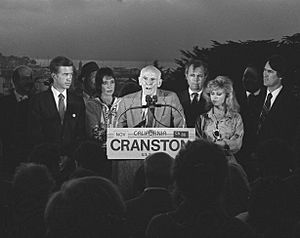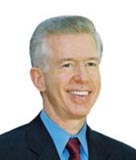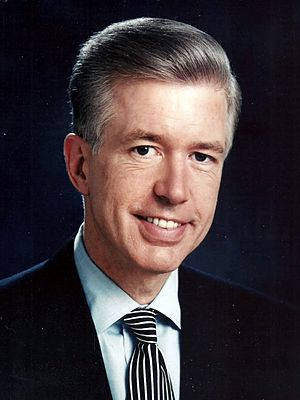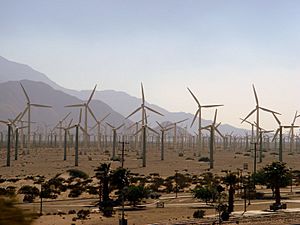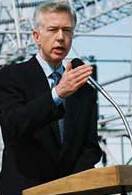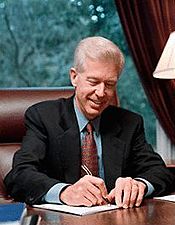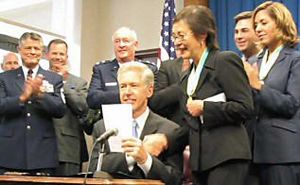Gray Davis facts for kids
Quick facts for kids
Gray Davis
|
|
|---|---|

Davis in 2010
|
|
| 37th Governor of California | |
| In office January 4, 1999 – November 17, 2003 |
|
| Lieutenant | Cruz Bustamante |
| Preceded by | Pete Wilson |
| Succeeded by | Arnold Schwarzenegger |
| 44th Lieutenant Governor of California | |
| In office January 2, 1995 – January 4, 1999 |
|
| Governor | Pete Wilson |
| Preceded by | Leo T. McCarthy |
| Succeeded by | Cruz Bustamante |
| 28th Controller of California | |
| In office January 5, 1987 – January 2, 1995 |
|
| Governor | George Deukmejian Pete Wilson |
| Preceded by | Kenneth Cory |
| Succeeded by | Kathleen Connell |
| Member of the California State Assembly from the 43rd district |
|
| In office December 6, 1982 – November 30, 1986 |
|
| Preceded by | Howard Berman |
| Succeeded by | Terry B. Friedman |
| Chief of Staff to the Governor of California | |
| In office 1975–1981 |
|
| Governor | Jerry Brown |
| Preceded by | Edwin Meese |
| Succeeded by | B. T. Collins |
| Personal details | |
| Born |
Joseph Graham Davis Jr.
December 26, 1942 New York City, U.S. |
| Political party | Democratic |
| Spouse | |
| Education | Stanford University (BA) Columbia University (JD) |
| Signature |  |
| Military service | |
| Branch/service | |
| Years of service | 1967–1969 |
| Rank | |
| Battles/wars | Vietnam War |
| Awards | Bronze Star |
Joseph Graham "Gray" Davis Jr. (born December 26, 1942) is an American lawyer and former politician. He served as the 37th Governor of California from 1999 until 2003. He was removed from office in 2003 after a special election called a recall. He was the second state governor in U.S. history to be recalled.
Davis is a member of the Democratic Party. He studied history at Stanford University and law at Columbia Law School. He was a captain in the Vietnam War and received a Bronze Star Medal for his service. Before becoming governor, Davis held several important roles. He was chief of staff for Governor Jerry Brown from 1975 to 1981. He also served as a California State Assemblyman (1983–1987), California State Controller (1987–1995), and the 44th Lieutenant Governor of California (1995–1999).
As governor, Davis focused on improving education. California spent billions more on schools during his first term. Standardized test scores in California went up for five years in a row. Davis also signed the first state law in the U.S. that required car makers to limit pollution from vehicles. He supported laws to ban certain types of weapons and worked to improve California's relationship with Mexico. Davis started his time as governor with high approval from voters. However, his popularity dropped because people blamed him for the California electricity crisis, a state budget problem, and an increase in car taxes.
On October 7, 2003, voters decided to remove Davis from office in the recall election. About 55.4% of voters supported his removal. He was replaced by actor Arnold Schwarzenegger on November 17, 2003. After leaving office, Davis became a lecturer at the UCLA School of Public Affairs and worked as a lawyer.
Contents
Early Life and Education
Gray Davis was born in the Bronx, New York City. He was the oldest of five children. His family moved to California in 1954.
Davis attended the Harvard School for Boys, a military academy in North Hollywood. He went to public, private, and Catholic schools. This experience helped him understand different school systems when he became a lawmaker.
Davis was accepted into Stanford University. He played on the Stanford golf team. He joined the ROTC to help pay for his education. This meant he promised to join the Army after finishing college. In 1964, he graduated from Stanford with a degree in history. He then went to Columbia Law School in New York City and earned his law degree in 1967.
Military Service
After law school, Davis joined the United States Army in 1967. He served in the Vietnam War until 1969. He was a captain and received a Bronze Star Medal for his service. Friends said that after the war, Davis became more serious and interested in politics. He realized that many soldiers in Vietnam were from different backgrounds than his own. This made him want to work to make America more fair. Davis is a lifelong member of the American Legion and the Veterans of Foreign Wars.
Early Political Career
Davis started his political career by volunteering for John V. Tunney's campaign for the United States Senate in 1970. He also helped Tom Bradley become Los Angeles's first Black mayor in 1973. This important victory inspired Davis to continue in politics. He ran for state treasurer in 1974 but did not win.
From 1975 to 1981, Davis worked as the chief of staff for Governor Edmund G. "Jerry" Brown Jr.. Davis was known for being more focused and organized than Governor Brown. When Brown was campaigning for president in 1980, Davis helped manage the state.
Davis then served as an Assemblyman for the 43rd district in Los Angeles County from 1983 to 1987. He supported a popular program to help find missing children by putting their pictures on milk cartons.
State Controller
In 1986, Davis ran for State Controller and won. He served in this role for eight years until 1995. As California's main financial officer, he worked to save taxpayer money. He did this by stopping fraud, reducing government waste, and finding misused public funds. He was the first controller to stop paychecks for all state elected officials, including himself, until the state budget was approved. He also helped return over $1.8 billion in forgotten money, like old bank accounts, to Californians.
1992 U.S. Senate Campaign
Davis ran for the Democratic nomination for the United States Senate in 1992. He was running to fill a Senate seat that had become open. He lost this election to Dianne Feinstein. This campaign is sometimes mentioned as an example of Davis's use of negative campaign ads. After this loss, Davis decided to take more control over his future campaigns.
Lieutenant Governor of California
Many people thought Davis's political career was over after his Senate loss. However, he put together a new campaign team. He won the election for lieutenant governor in 1994. Davis ran as a moderate candidate.
As lieutenant governor until 1999, Gray Davis focused on California's economy. He worked to bring new businesses to the state. He also worked to keep college education affordable for families. He oversaw the largest reduction in student fees in California's history. In this role, he was also President of the State Senate and a Regent of the University of California.
Governor of California
1998 Gubernatorial Campaign
In the June primary election, Davis surprised many by winning against two well-funded Democratic opponents. His campaign slogan was "Experience Money Can't Buy." Davis won the 1998 general election for governor with 57.9% of the vote. He defeated Republican Attorney General Dan Lungren. Davis presented himself as a moderate Democrat. He promised to improve California's public schools, which was a top concern for voters.
First Term as Governor
Focus on Education
In 1998, Davis became California's first Democratic governor in 16 years. He was seen as very prepared for the job. His approval ratings were high when he first started.
Davis's first action as governor was to call a special meeting of the state legislature. He wanted to discuss his plan for all California children to be able to read by age 9. He often said that his passion for education was why he ran for governor.
Davis used California's growing budget money to increase spending on education. He signed laws for new statewide testing and accountability programs. He also supported the high school exit exam. He expanded the Cal Grant program, which helps students pay for college. Under Davis, California started recognizing students for excellent academic achievement. His Governors Scholarship program gave $1,000 scholarships to top students.
Davis signed a law that guaranteed admission to a University of California school for students who finished in the top 4% of their high school class. Public schools received $8 billion more than required by law during his first term. Davis also increased spending to hire more qualified teachers. He helped pass a statewide vote to make it easier for local schools to get money for improvements. He set aside $3 billion for new textbooks and increased spending per student.
In 2001, Governor Davis signed a bill that set nutrition standards for food in elementary schools. It also banned the sale of sugary drinks in elementary and middle schools.
Public Safety and Guns
Davis signed laws in 1999 that banned certain types of weapons. These laws also limited handgun purchases to one per month and required safety locks on new firearms. In 2001, he signed a bill requiring gun buyers to pass a safety test.
Davis supported the death penalty and stricter sentencing laws. He often denied requests for parole from prisoners.
Improving Relations with Mexico
Early in 1999, Davis worked to improve California's relationship with Mexico. He believed that California had missed out on trade opportunities. Davis met with Mexican presidents multiple times to strengthen ties. Under his leadership, Mexico became California's top export market. California's trade with Mexico grew significantly.
Health and Environment
Davis expanded health coverage for low-income children. He signed laws that gave patients more rights with their health insurance plans, including the right to get a second opinion. He also improved staff-to-patient ratios in nursing homes.
California's anti-tobacco campaign became one of the largest in the nation under Davis. He signed bills to ensure age verification for tobacco sales and increased penalties for untaxed cigarettes. He also expanded smoke-free zones around public buildings.
In 2002, Davis signed the first state law in the U.S. to require car makers to limit greenhouse gas emissions from vehicles. In 2003, he signed a law to ban unwanted junk email.
Davis also worked to protect the environment by increasing spending for parks and opposing offshore drilling. He issued an order to remove a toxic gasoline additive called MTBE from gasoline.
California Electricity Crisis
Soon after becoming governor, Davis helped speed up the building of new power plants. However, these plants were not ready before the California electricity crisis began.
In 2000, California experienced rolling blackouts due to low power supply. On January 17, 2001, Davis declared a state of emergency. Energy trading companies, like Enron Corporation, were found to have illegally limited power supply to drive up prices. California had to buy power at very high costs.
The Davis administration started a power saving program with TV ads and financial rewards. These efforts helped reduce electricity use by 14.1% in one year.
Critics blamed Davis for not responding quickly enough to the crisis. His supporters said he did all he could and blamed the energy companies. Years later, when Enron and other companies were found guilty of manipulating the market, Davis felt his actions were justified. He said that the actions of these companies were a major reason for his recall.
On November 13, 2003, Davis officially ended the state of emergency related to the energy crisis. During this time, California approved licenses for 38 new power plants. These new plants helped prevent future blackouts and provided California with a cheaper energy supply.
Budget Challenges
During California's economic boom, the state budget grew to support Davis's new programs. California had record budget surpluses. Davis also cut taxes by over $5.1 billion, including a sales tax cut.
However, the "dot-com boom" ended, and California's tax revenues dropped sharply. This created budget problems. Davis had to increase vehicle registration fees to help close the budget gap, which was unpopular.
Declining Popularity
Davis's popularity began to decline in May 2001 during the electricity crisis. By April 2003, his approval rating was very low. The main reasons for his declining popularity were the electricity crisis, higher electricity rates, and the increase in car registration taxes.
Davis tried to find a middle ground in his policies, but he ended up upsetting both liberals and conservatives. Some were unhappy that he cut school spending while increasing prison spending to balance the budget.
2002 Gubernatorial Campaign
Davis started raising money for his 2002 re-election campaign very early. He raised large amounts of money, which drew attention.
During the 2002 election, Davis used campaign ads against his Republican opponent, Richard Riordan, even during the Republican primary. Polls showed that Riordan, a moderate, would be a strong challenger. Davis's negative ads helped the more conservative candidate, Bill Simon, win the Republican primary.
Davis was re-elected in November 2002 after a difficult campaign against Simon. The campaign involved accusations of ethical problems on both sides. Davis's campaign highlighted improvements in education, environmental protection, and health insurance for children. The 2002 governor's race was the most expensive in California history. Davis won, but many voters still did not approve of his job performance.
Second Term and Recall
Davis's second term lasted only ten months. It was dominated by the recall election. He was criticized for increasing vehicle registration fees to deal with the budget crisis. He also signed laws allowing driver's licenses for undocumented immigrants and giving domestic partners more rights.
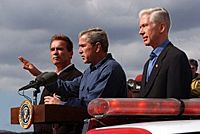
Davis was governor during the major southern California wildfires in October 2003, known as the Cedar Fire. He declared a state of emergency and sent the National Guard to help. This was the last major event during his time as governor. Both Davis and the incoming governor, Arnold Schwarzenegger, worked together to help with disaster relief.
Davis served 1,778 days as governor. He signed 5,132 bills into law and vetoed 1,112 bills.
Recall Election
In July 2003, enough signatures were collected to hold a recall election. This was the first time a California governor faced a recall. The effort was partly funded by U.S. Representative Darrell Issa.
Davis called the recall an "insult" to the millions of voters who elected him in 2002. His campaign focused on convincing voters to say "no" to the recall. He argued that the recall was a waste of money and could allow someone with very few votes to become governor. Davis tried to show himself as a hard-working governor who had improved education and healthcare.

In September 2003, Davis admitted he had lost touch with voters and began holding town hall meetings. He blamed some of the state's problems on his predecessor, Pete Wilson, and on Republicans in the legislature. He called the recall a "right-wing power grab."
On October 7, 2003, voters decided to recall Davis. About 55.4% of voters supported his removal. Republican Arnold Schwarzenegger was elected to replace him. Davis is the second governor in U.S. history to be recalled.
On the night of the recall, Davis accepted his defeat. He thanked Californians for electing him five times statewide. He spoke about his administration's achievements in education, environmental protection, and health insurance for children. Davis promised to help Schwarzenegger with the transition. His last day in office was November 17, 2003.
Life After Politics
In December 2004, Davis joined the law firm of Loeb & Loeb.
He has given several media interviews about his time as governor. He appeared in the documentary Enron: The Smartest Guys in the Room.
The discussion about his legacy and his role in the energy crisis continues. In 2005, Davis said he felt justified because it was revealed that Enron had manipulated the energy market. He also said he was not interested in running for governor again.
In 2006, Davis was a guest lecturer at UCLA's School of Public Policy. He also wrote an introduction for a book about the Amber Alert system, which helps find missing children.
On April 23, 2007, Davis was appointed to the Board of Directors of the animation company DiC Entertainment. In May 2009, he was a keynote speaker at the Columbia Law School graduation.
In September 2024, Davis was one of several former governors who signed an open letter. This letter urged all 50 current governors to confirm their states' votes after the November election.
Personal Life
Gray Davis met his wife, Sharon Ryer, in 1978 while on an airplane for work. They married in 1983.
See also
 In Spanish: Gray Davis para niños
In Spanish: Gray Davis para niños


